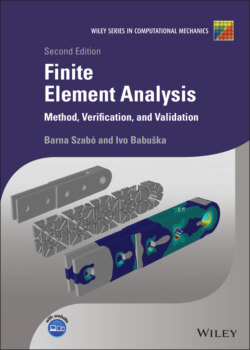Читать книгу Finite Element Analysis - Barna Szabó - Страница 44
Error estimation based on extrapolation
ОглавлениеFor most practical problems the estimate (1.92) is sufficiently sharp so that the less than or equal sign (≤) can be replaced by the approximately equal sign (≈) and this a priori estimate can be used in an a posteriori fashion.
The computed values of the potential energy corresponding to a sequence of finite element spaces can be used for estimating the error in energy norm by extrapolation. Sequences of finite element spaces that have this property are called hierarchic sequences. By Theorem 1.5 and eq. (1.92) we have:
(1.95)
where . There are three unknowns: , and β. Assume that we have a sequence of solutions corresponding to the hierarchic sequence of finite element spaces . Let us denote the corresponding computed potential energy values by , , πi and the degrees of freedom by , , Ni. We will denote the estimate for by π∞. With this notation we have:
(1.96)
(1.97)
On dividing eq. (1.96) with eq. (1.97) and taking the logarithm we get
(1.98)
and, repeating with substituted for i, it is possible to eliminate to obtain:
(1.99)
where
Equation (1.99) can be solved for π∞ to obtain an estimate for the exact value of the potential energy.
The relative error in energy norm corresponding to the ith finite element solution in the sequence is estimated from
(1.100)
Usually the percent relative error is reported. This estimator has been tested against the known exact solution of many problems of various smoothness. The results have shown that it works well for a wide range of problems, including most problems of practical interest; however, it cannot be guaranteed to work well for all conceivable problems. For example, this method would fail if the exact solution would happen to be energy‐orthogonal to all basis functions associated with (say) odd values of i.
Remark 1.12 From equation (1.92) we get
(1.101)
On plotting vs. N on log‐log scale a straight line with the slope will be seen for sufficiently large N. The estimated value of β, corresponding to the ith solution in the sequence, is denoted by βi. It is computed from eq. (1.98):
(1.102)
